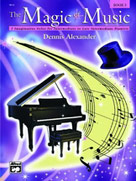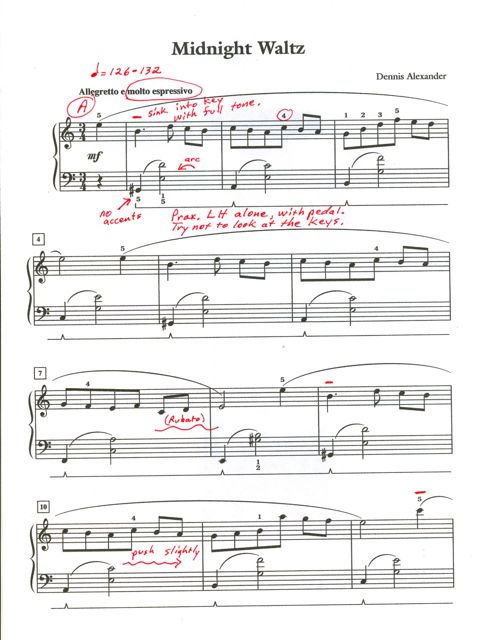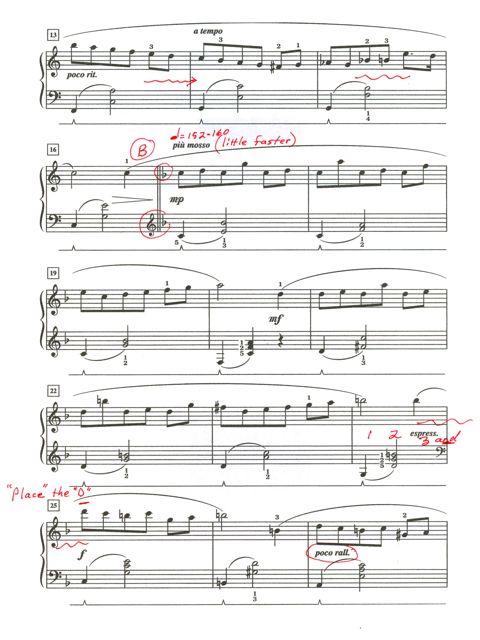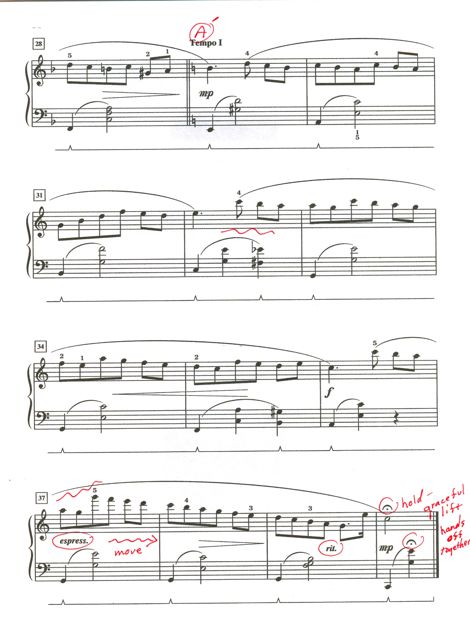"Midnight Waltz" from The Magic of Music, Bk. 3

I've always felt that music inspires magic, and everyone who experiences the joy of making music themselves develops the ability to discover this magic in one way or another. Perhaps it is that special feeling which occurs when a certain rhythm or colorful harmony touches the heart of the player; or maybe it is that favorite melodic line that inspires him or her to 'sing inside' and feel the warmth of a beautifully turned phrase. The pieces in this collection are designed to entertain, teach and enhance the important musical and technical skills that are being developed at the intermediate level.

Click on score to enlargeThere are 7 solos in this collection, and 'Midnight Waltz' is one of my favorites. Over the years, I have had numerous students who wanted to play a Chopin waltz before their technique was at a level to sufficiently meet the demands of those charming pieces. Consequently, I was always on the lookout for a waltz that 'sounded' like Chopin, and helped pave the way for a student's immersion into those magical compositions. This particular piece is one of those: it's much easier, mostly because of the way I have structured the left hand. The rhythm of this left hand accompaniment allows time to jump down and prepare that 1st note of the next measure. Most of the intervals on beat two consist of 6ths and 7ths, so this also helps the student to achieve accuracy and security when playing hands together. Practice that LH all by itself and try to avoid accenting beat one of each measure by gently floating over to the left in a relaxed 'arc' motion immediately after playing beat 2.When practicing the RH melody line, listen carefully to make sure that the 1st note of each phrase is never accented, for this is a weak beat (beat 3). Begin with a graceful and gentle 'lift' of the wrist, and sink into that first note of ms. 1 with a full, ringing tone. Listen for a smooth, molto legato sound and shape that long four-measure phrase beautifully, tapering off gently at the end. Notice that I have marked the tempo to be 'Allegretto e molto espressivo', so feel free to bend the rhythm here and there to help generate this expressive quality. A tasteful rubato is always critical in these romantic style works-- it needs to be subtle and never overdone. I have used a wavy line to indicate some places where rubato would be most appropriate.

The 'B' section of this piece is marked 'piu mosso', so let the tempo move forward with a bit of urgency. Notice the tempo suggestion of quarter note = 152-160. Be sure your student notices the change of clef sign as well as the change of key signature to F major. Each of these long four-measure phrases grows in intensity, with the first one starting at 'mp', the second one beginning 'mf' and finally at ms. 25, with the leap up to high D, we arrive at a 'f' level. Please take a little time over the barline of ms. 24 (exaggerate the 'and' of beat 3) and 'place' the high D just slightly past beat one to help give is warmth and significance. (Be sure that the hands play right together on the downbeat.)

The 'poco rallentando' brings us right back to the key of C major (original tempo now) with a return to the 'A' section and ms. 32 takes us right into the codetta with those colorful chords in the LH. Take a little time in this measure, and then move right back into tempo in ms. 33. Then, as you move into the last line, stretch that big leap in the RH in ms. 37 (marked 'espressivo') and then move forward once again toward the 'rit.' and final cadence. Don't be in a hurry to leave the keys after you play that last chord-- keep both hands on the keyboard (count 5 beats) and then slowly and gracefully allow the wrist to pull the hands up and off the keys and bring your arms gently to the lap. An artistic closing 'gesture' is very important to learn, as this is the last impression that you leave with your audience and the choreography needs to match the character and tempo of the piece you are playing.




